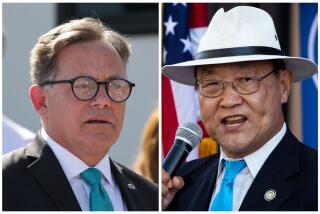Getting the Teamsters’ House in Order : Ron Carey, the beleaguered reformer, fights the old guard threatened by loss of perks.
- Share via
Teamsters union President Ron Carey won a significant battle last Thursday in one of the most bitter internal union struggles since the fight against communist influence in the labor movement more than four decades ago.
The struggle over communism is now just a vague memory, but the ugly civil war for control of the 1.4-million-member Teamsters union is far from over.
Carey’s victory came when the union executive board voted to abolish the union’s four regional conferences, or divisions, that have been centers of furious opposition from old-guard Teamsters seeking to regain the presidency Carey won more than two years ago in the union’s first-ever nationwide secret-ballot election.
Carey and his allies in the leadership won election as reformists pledged to eliminate all vestiges of corruption and waste that have plagued the nation’s largest private-sector union for so many years.
It was an honest election supervised by a government-appointed monitor, Michael Holland. Other government-appointed investigators and prosecutors kicked out mobsters and mob-linked officials who had dominated the top echelon of the union since they infiltrated it in the 1950s.
Almost all officers tied to the underworld are gone, but those who tolerated mobsters in top offices are fuming because Carey and his reformists are shaking up longstanding procedures and appointing what the old guard says are inexperienced men and women to staff jobs across the country.
Carey has been breaking up an “old boy” network that often won good union contracts for members but curbed democracy in the union and gave its officials lavish salaries and expense accounts.
Officers of the four union divisions are spending about $14 million a year on work that Carey insists can be done by lower-level units of the union or by officers and staff in the national headquarters in Washington.
Each of the heads of the four conferences was defeated for a top national post in the election Carey won, but they still hold other well-paying jobs in the union at local or regional levels. And they and their supporters are determined to continue fighting Carey inside the union and through the courts.
The international union’s constitution is pretty clear about the power of the executive board to abolish the four conferences, which are only arms of the international union; but the continued internal fighting can only weaken the union, and so far there seems to be no attempt to end it.
Losing the power that comes with running the conferences, which help manage local unions, is just one cause of the almost desperate battle conference leaders waged to keep them. Another is money.
One example, and not untypical, is the income of Michael J. Riley, chairman of the Western Conference of Teamsters, who, like others who lost the latest battle with Carey, draws multiple salaries from the union. Riley was getting a salary from his job as president of his local union in Los Angeles, another as head of the Southern California Joint Council 42, plus $187,000 as head of Western Conference, for a total of more than $300,000 a year, according to Carey.
When asked how much time he spent on the job to justify three salaries plus expenses, Riley told the executive board that he has three full-time jobs and works “14 to 15 hours a day, seven days a week.”
He also insisted that last year he dropped his $29,073-a-year salary from his Los Angeles local union, adding that “if you’re looking for greed, you got the wrong guy because I could be making $360,000 instead of $250,000.”
Now, by Carey’s standards that is still greed, since it doesn’t include expenses. But Riley and others like him in the union are pikers when their pay is compared with the income of corporate executives, which runs into the millions.
Riley’s duties are as extensive as most corporate executives since he is, in effect, CEO of about 400,000 Teamsters. And while corporate-executive salaries are outrageously high, Riley represents workers, not shareholders; his members did not approve his various salaries.
Thus far, Carey appears to be winning the internal warfare, but the Teamsters need to put an end to it by getting both sides together to negotiate a peace treaty. Then, they need to get back to the business of helping the union’s hard-working members.


